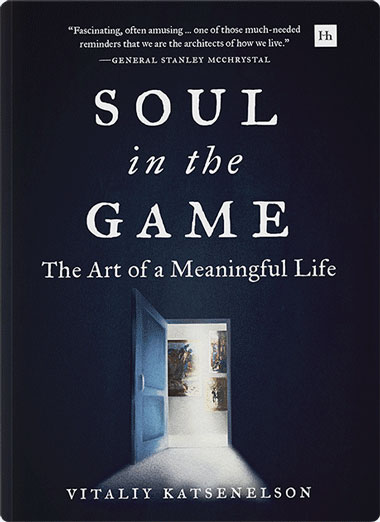“Fascinating, often amusing… one of those much-needed reminders that we are the architects of how we live.”
General Stanley McChrystal
Author, Risk, A User’s Guide
From 2001 to 2007 I taught a graduate investment class at the University of Colorado at Denver. I was an adjunct (a fancy word for part-time) professor. Teaching was a hobby; I did not have an ambition to pursue a career in academia. But I discovered that I liked sharing knowledge, and teaching was a new and interesting challenge.
It was 2006, my fifth year and tenth semester of teaching, and the current semester’s lectures started to blur with the ones I had delivered before. To keep teaching interesting, I simply stopped preparing for lectures. I am a more engaging speaker when there is some degree of spontaneity. I knew the material by heart – after all, I practiced it in my day job. I’d come up with analogies in real time. This lack of preparation kept my relationship with teaching interesting, even a bit exciting.
One day I showed up to class, opened the syllabus and found we had discounted cash flow (DCF) analysis on the menu. DCF is a foundational concept of the valuation of a company or any asset that generates or will generate cash flows in the future (it will not help you with cryptos or NFTs, sorry). I don’t know if my subconscious was triggered by the milkshake I had the day before or by the steak I had for lunch, but I started with “Imagine you are a farmer about to buy a cow. How much would you pay for that cow?” Must have been the milkshake, since I continued; “The cow is going to produce X amount of milk a year, which you’ll sell for Y dollars a gallon. You’ll have these costs – hay, a veterinarian, a barn, etc. Over her lifetime this cow will give you so many calves, which you’ll sell for Z dollars. And then, at the end of year seven – depending on whether you like a happy or a sad ending to the story – she’ll be sold to either a petting zoo or a butcher.
Alright, this essay on creativity will take a short detour to investment basics. I know you didn’t expect that – you and I are in the same boat; I didn’t, either.
In broad strokes, valuing any asset is not any different than valuing a cow. You have ongoing cash flows (from the milk) and one final, large cash payment, which is the terminal value (the asset value at a distant point in the future, at the petting zoo moment). There are two more steps: A dollar in seven years is worth less than a dollar in your pocket today. So you need to discount all these cash flows at an appropriate rate back into today’s dollars. This tells you how much the cow is worth. And finally, now that you know what it’s worth, you need to decide what price you actually want to pay for it. The more confidence you have in internal factors like the cow’s longevity (quality) and external factors like the price of milk, hay, taxation, and others, the less risk you are taking and thus the smaller margin of safety you’ll need (and vice versa).
I just summed up my job of valuing stocks in very broad strokes.
A few days later, on a Saturday morning, I was sitting in my basement and working on the valuation chapter of my first book, Active Value Investing (Wiley, 2007). I was stuck. Valuation can be a very dry and boring topic. I wanted to spice it up but could not find a way to do it. After staring at the blank screen for a few hours, out of boredom I started listening to Barbara Streisand’s “Papa Can You Hear Me” from Yentl on YouTube. A dozen songs, a still blank page, and an hour later I found myself deep in Fiddler on the Roof, listening to “If I Was a Rich Man.”
And then…
My subconscious melded Fiddler on the Roof with the lecture from a few days earlier, and I ended up writing a chapter about the Jewish farmer Tevye buying a cow, Golde (which he named after his first wife). In that chapter I went through above exercise in much greater detail. Suddenly what should have been a boring chapter, lit up. This is my favorite chapter by a mile. To this day, fifteen years later, it is very dear to me. I was writing a finance book about investing, filled with seventy-five charts and tables, and suddenly smack in the middle of it appears a Jewish farmer and some light humor.
Here is what I learned from writing this chapter.
“Exercise the writing muscle every day, even if it is only a letter, notes, a title list, a character sketch, a journal entry. Writers are like dancers, like athletes. Without that exercise, the muscles seize up.”
Jane Yolen
Show up. Some writers have a goal: Write so many words per day; and it works for them. I don’t do that. I create space to write. I just show up every day in the morning and let randomness and my subconscious interact. I found that, for me, writing is not words per day but an hour or two a day of adventure.
Many days appear to be unproductive – after staring at the computer for two hours I have nothing to show for it. Over the years I’ve learned not to criticize myself for that. Instead, I tell myself: Not yet. Tomorrow.
My only expectation is that I’ll give my writing a chance for an hour or two every day. That’s it. The rest is not up to me. If it sounds like I am taking a leap of faith, I do! But I am not bowing to a supreme being but to the power of our subconscious mind. Think of it as a giant computer (think Amazon Web Services) that is so much more powerful than our conscious mind (think iPhone).
Almost two decades of writing have taught me that the subconscious mind is where the magic happens. Even on the days when I have nothing to show but a blank screen, I have planted seeds of future articles in my subconscious. I just don’t know when they will bear fruit. I have to keep watering them every day by showing up. Since I have little control of when and where the right words will appear on the screen, I keep expectations low.
You do you. I also learned that in Tevye’s chapter I was pushing my creativity to the limit. But it was more than just that. Now I realize that I was pushing how I allowed myself to write. I was still discovering my voice. I was new to writing – it was barely my third year at this craft.
Allowing myself to be me was liberating. “Be yourself” sounds easy, but it is anything but. I, like most of us, am full of insecurities. I had a wall full of framed diplomas and professional experience that were an admission ticket and, most importantly, provided much-needed confidence to write about finance. Still, in this chapter, as Vitaliy the finance book writer, I was venturing into unfamiliar and thus less comfortable territory.
The Tevye chapter was the most personal chapter in the book. It was the only chapter where “me being me” was allowed. Rereading this chapter now, I can see how I was still being very guarded in my writing. But I was taking important first steps in being less polished and coming out from hiding behind the wall of numbers and facts. Readers love information delivered to them via sterile facts and numbers as much as they love the sterility of hospital rooms. Bringing a little bit of “me” into the writing about what otherwise could have been a boring subject made it more digestible, relatable, and personal.
In this chapter I was also paying tribute to my ancestors, who, two centuries before, were just like Tevye: deeply religious farmers in Eastern Europe, full of wit, pragmatism, and big hearts.
(I had an opportunity to improve the Tevye chapter in a few years later in The Little Book of Sideways Markets).
This brings me to another lesson – story telling. Story telling is a less efficient way of writing, at least from the word-count-per-message perspective, but it is usually the most effective. Stories add flavor to the message and make it memorable. To this day I spend more time thinking about how I am going to say something than about what I am going to say.
Be multidimensional. Steve Jobs, in his 2005 commencement speech at Stanford, brilliantly pointed out that when we look at what we have created, we can connect the dots only by looking back. I did not watch Fiddler on the Roof a decade before that fateful Saturday morning when I wrote about Tevye because I thought that at some point, when I wrote a book called Active Value Investing, I’d need to explain discounted cash flows and Tevye would come in very handy. Of course not. I watched it because I liked the music and thought the plot was interesting. This is why we need to keep exposing ourselves to disciplines and experiences that lie far outside our main activity. By being multidimensional, we actually fortify our main dimension. And also, we should just watch musicals and listen to music for fun.
To this day I remain in awe of the randomness of the creative process. What if I hadn’t drunk a milkshake or eaten a steak before the lecture? What if I hadn’t taught a class on valuation that week? What if a YouTube algorithm sent me to Funny Girl instead? I could keep going – there are so many what ifs. I know this: If it wasn’t the Tevye example it would have been another one. As long as I keep showing up for an hour or two every single day, there will always be one, just not every day.

Dubbed “the new Benjamin Graham” by Forbes, Vitaliy is the CEO of a value investing firm, author of several books, and a prolific writer on topics as diverse as investing, parenting, classical music, and self-improvement. You can read his articles at Investor.fm or listen to them on his podcast, The Intellectual Investor.
“Fascinating, often amusing… one of those much-needed reminders that we are the architects of how we live.”
General Stanley McChrystal
Author, Risk, A User’s Guide
“Soul in the Game is a beautiful way to search for the lost value of happiness, strength and health.”
Wim Hof
Author, The Wim Hof Method

“Vitaliy knows how to tell a story. This book reads like a conversation with Vitaliy: deep, insightful, inquisitive and civilized.”
Nassim Nicholas Taleb
Author, The Black Swan
“Vitaliy Katsenelson has been singled out by financial media for his brilliant investment strategies, but perhaps even more impressive are his philosophical writings.”
Carl Bernstein
Author, All the Presidents Man
Leave a review and send a link or a screenshot of the review to bonus@soulinthegame.net to receive 6 new pieces (35 pages of content!)